SCH 3227, Module: Human Disease, Asthma Physiology Detailed Report
VerifiedAdded on 2023/01/19
|12
|3575
|32
Report
AI Summary
This report delves into the physiology of asthma, a common airway disease characterized by swollen airways, leading to symptoms like coughing, shortness of breath, and wheezing. It explores the causes, including environmental factors, smoking, and genetic predispositions, alongside the underlying pathophysiology involving airway inflammation and bronchoconstriction. The report discusses treatment options, such as inhaled corticosteroids and beta-agonists, and emphasizes the importance of early intervention and management. It also examines the disease's impact on the lungs, including hyperinflation, mucus accumulation, and epithelial changes, providing a comprehensive overview of asthma's mechanisms and clinical implications. The report is based on a student assignment, and offers a detailed analysis of the causes, treatments, and consequences of asthma.

Running head: PHYSIOLOGY OF ASTHMA
Physiology of Asthma
Name of the Student
Name of the University
Author Note
Physiology of Asthma
Name of the Student
Name of the University
Author Note
Paraphrase This Document
Need a fresh take? Get an instant paraphrase of this document with our AI Paraphraser
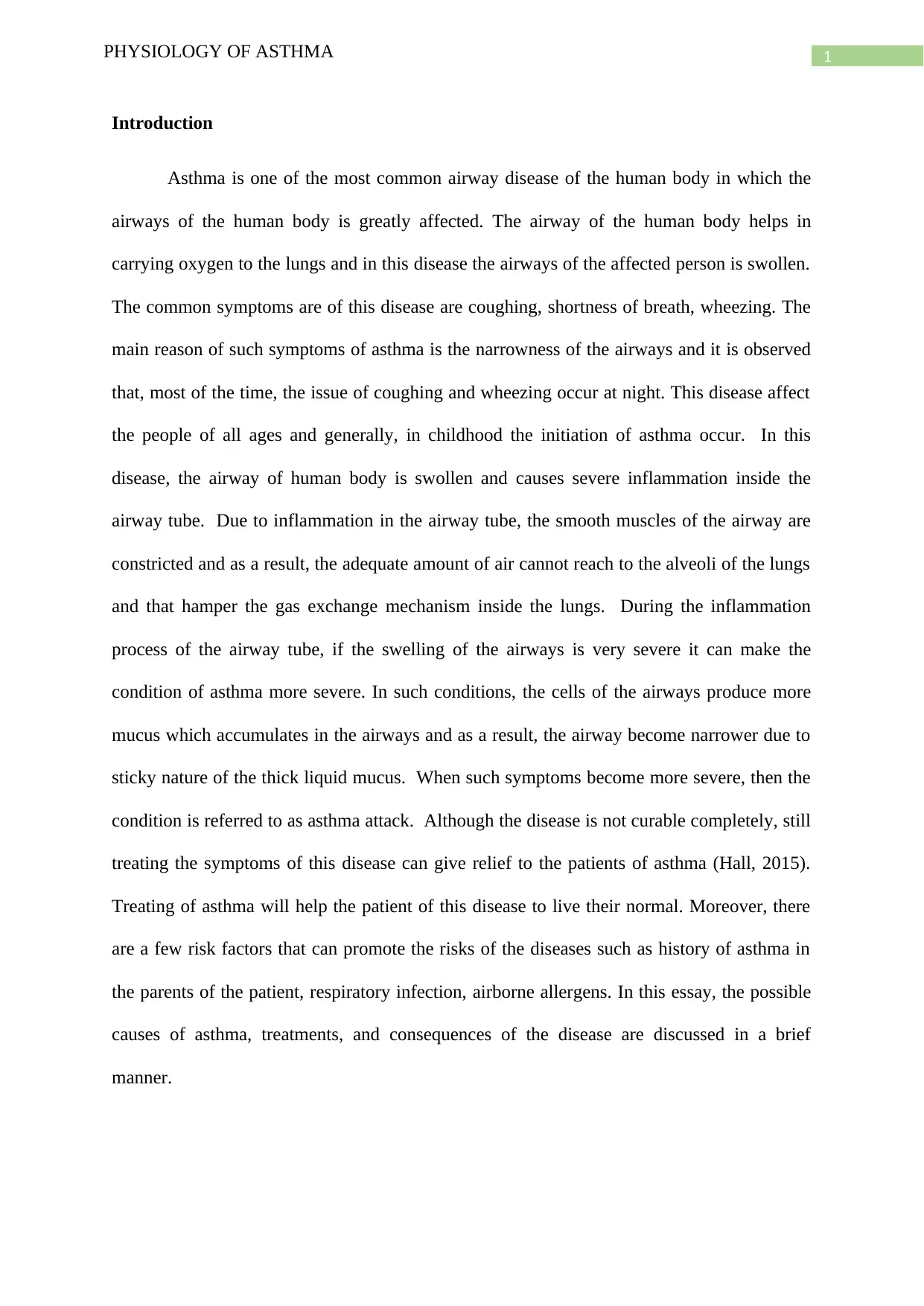
1PHYSIOLOGY OF ASTHMA
Introduction
Asthma is one of the most common airway disease of the human body in which the
airways of the human body is greatly affected. The airway of the human body helps in
carrying oxygen to the lungs and in this disease the airways of the affected person is swollen.
The common symptoms are of this disease are coughing, shortness of breath, wheezing. The
main reason of such symptoms of asthma is the narrowness of the airways and it is observed
that, most of the time, the issue of coughing and wheezing occur at night. This disease affect
the people of all ages and generally, in childhood the initiation of asthma occur. In this
disease, the airway of human body is swollen and causes severe inflammation inside the
airway tube. Due to inflammation in the airway tube, the smooth muscles of the airway are
constricted and as a result, the adequate amount of air cannot reach to the alveoli of the lungs
and that hamper the gas exchange mechanism inside the lungs. During the inflammation
process of the airway tube, if the swelling of the airways is very severe it can make the
condition of asthma more severe. In such conditions, the cells of the airways produce more
mucus which accumulates in the airways and as a result, the airway become narrower due to
sticky nature of the thick liquid mucus. When such symptoms become more severe, then the
condition is referred to as asthma attack. Although the disease is not curable completely, still
treating the symptoms of this disease can give relief to the patients of asthma (Hall, 2015).
Treating of asthma will help the patient of this disease to live their normal. Moreover, there
are a few risk factors that can promote the risks of the diseases such as history of asthma in
the parents of the patient, respiratory infection, airborne allergens. In this essay, the possible
causes of asthma, treatments, and consequences of the disease are discussed in a brief
manner.
Introduction
Asthma is one of the most common airway disease of the human body in which the
airways of the human body is greatly affected. The airway of the human body helps in
carrying oxygen to the lungs and in this disease the airways of the affected person is swollen.
The common symptoms are of this disease are coughing, shortness of breath, wheezing. The
main reason of such symptoms of asthma is the narrowness of the airways and it is observed
that, most of the time, the issue of coughing and wheezing occur at night. This disease affect
the people of all ages and generally, in childhood the initiation of asthma occur. In this
disease, the airway of human body is swollen and causes severe inflammation inside the
airway tube. Due to inflammation in the airway tube, the smooth muscles of the airway are
constricted and as a result, the adequate amount of air cannot reach to the alveoli of the lungs
and that hamper the gas exchange mechanism inside the lungs. During the inflammation
process of the airway tube, if the swelling of the airways is very severe it can make the
condition of asthma more severe. In such conditions, the cells of the airways produce more
mucus which accumulates in the airways and as a result, the airway become narrower due to
sticky nature of the thick liquid mucus. When such symptoms become more severe, then the
condition is referred to as asthma attack. Although the disease is not curable completely, still
treating the symptoms of this disease can give relief to the patients of asthma (Hall, 2015).
Treating of asthma will help the patient of this disease to live their normal. Moreover, there
are a few risk factors that can promote the risks of the diseases such as history of asthma in
the parents of the patient, respiratory infection, airborne allergens. In this essay, the possible
causes of asthma, treatments, and consequences of the disease are discussed in a brief
manner.
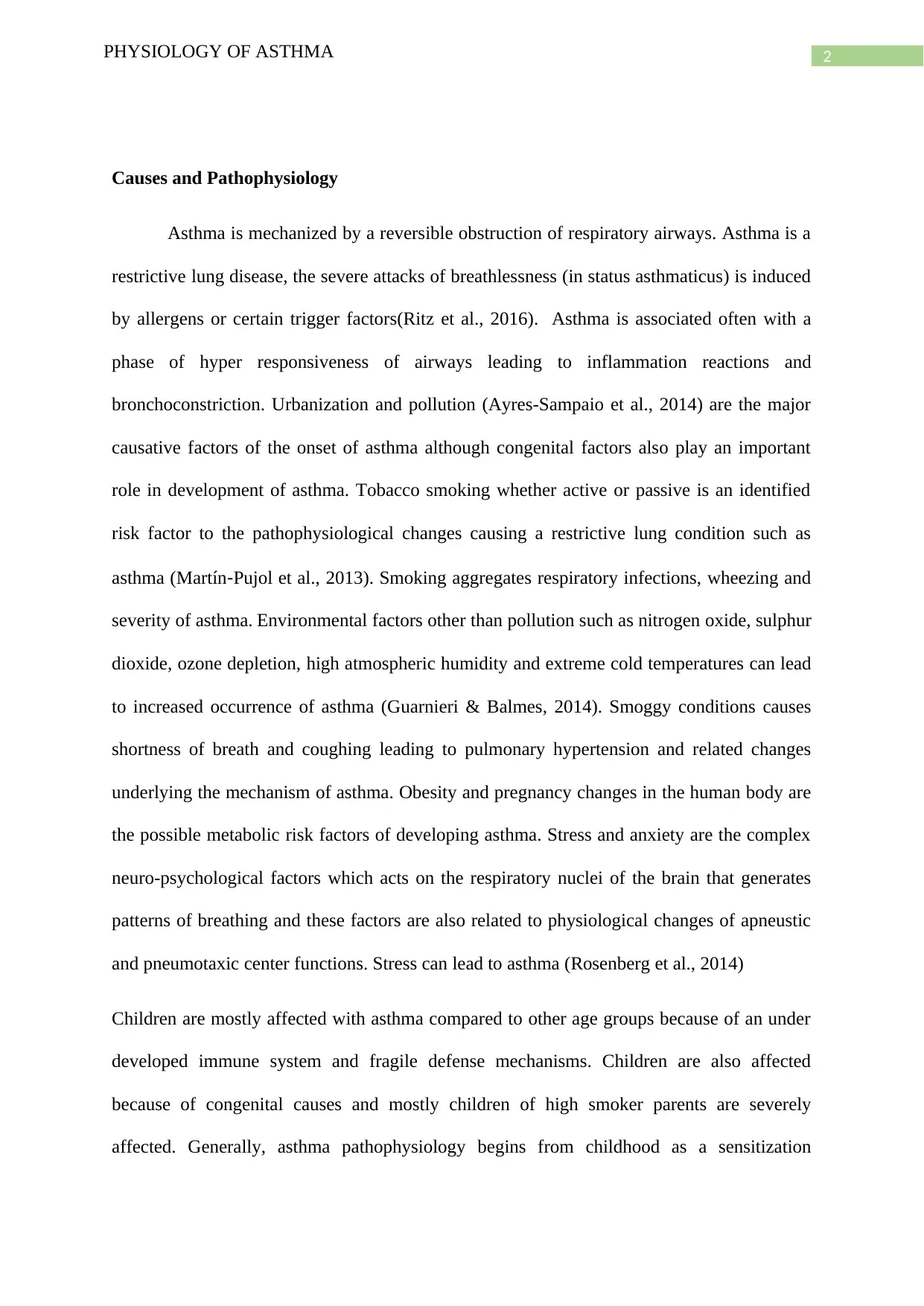
2PHYSIOLOGY OF ASTHMA
Causes and Pathophysiology
Asthma is mechanized by a reversible obstruction of respiratory airways. Asthma is a
restrictive lung disease, the severe attacks of breathlessness (in status asthmaticus) is induced
by allergens or certain trigger factors(Ritz et al., 2016). Asthma is associated often with a
phase of hyper responsiveness of airways leading to inflammation reactions and
bronchoconstriction. Urbanization and pollution (Ayres-Sampaio et al., 2014) are the major
causative factors of the onset of asthma although congenital factors also play an important
role in development of asthma. Tobacco smoking whether active or passive is an identified
risk factor to the pathophysiological changes causing a restrictive lung condition such as
asthma (Martín‐Pujol et al., 2013). Smoking aggregates respiratory infections, wheezing and
severity of asthma. Environmental factors other than pollution such as nitrogen oxide, sulphur
dioxide, ozone depletion, high atmospheric humidity and extreme cold temperatures can lead
to increased occurrence of asthma (Guarnieri & Balmes, 2014). Smoggy conditions causes
shortness of breath and coughing leading to pulmonary hypertension and related changes
underlying the mechanism of asthma. Obesity and pregnancy changes in the human body are
the possible metabolic risk factors of developing asthma. Stress and anxiety are the complex
neuro-psychological factors which acts on the respiratory nuclei of the brain that generates
patterns of breathing and these factors are also related to physiological changes of apneustic
and pneumotaxic center functions. Stress can lead to asthma (Rosenberg et al., 2014)
Children are mostly affected with asthma compared to other age groups because of an under
developed immune system and fragile defense mechanisms. Children are also affected
because of congenital causes and mostly children of high smoker parents are severely
affected. Generally, asthma pathophysiology begins from childhood as a sensitization
Causes and Pathophysiology
Asthma is mechanized by a reversible obstruction of respiratory airways. Asthma is a
restrictive lung disease, the severe attacks of breathlessness (in status asthmaticus) is induced
by allergens or certain trigger factors(Ritz et al., 2016). Asthma is associated often with a
phase of hyper responsiveness of airways leading to inflammation reactions and
bronchoconstriction. Urbanization and pollution (Ayres-Sampaio et al., 2014) are the major
causative factors of the onset of asthma although congenital factors also play an important
role in development of asthma. Tobacco smoking whether active or passive is an identified
risk factor to the pathophysiological changes causing a restrictive lung condition such as
asthma (Martín‐Pujol et al., 2013). Smoking aggregates respiratory infections, wheezing and
severity of asthma. Environmental factors other than pollution such as nitrogen oxide, sulphur
dioxide, ozone depletion, high atmospheric humidity and extreme cold temperatures can lead
to increased occurrence of asthma (Guarnieri & Balmes, 2014). Smoggy conditions causes
shortness of breath and coughing leading to pulmonary hypertension and related changes
underlying the mechanism of asthma. Obesity and pregnancy changes in the human body are
the possible metabolic risk factors of developing asthma. Stress and anxiety are the complex
neuro-psychological factors which acts on the respiratory nuclei of the brain that generates
patterns of breathing and these factors are also related to physiological changes of apneustic
and pneumotaxic center functions. Stress can lead to asthma (Rosenberg et al., 2014)
Children are mostly affected with asthma compared to other age groups because of an under
developed immune system and fragile defense mechanisms. Children are also affected
because of congenital causes and mostly children of high smoker parents are severely
affected. Generally, asthma pathophysiology begins from childhood as a sensitization
⊘ This is a preview!⊘
Do you want full access?
Subscribe today to unlock all pages.

Trusted by 1+ million students worldwide
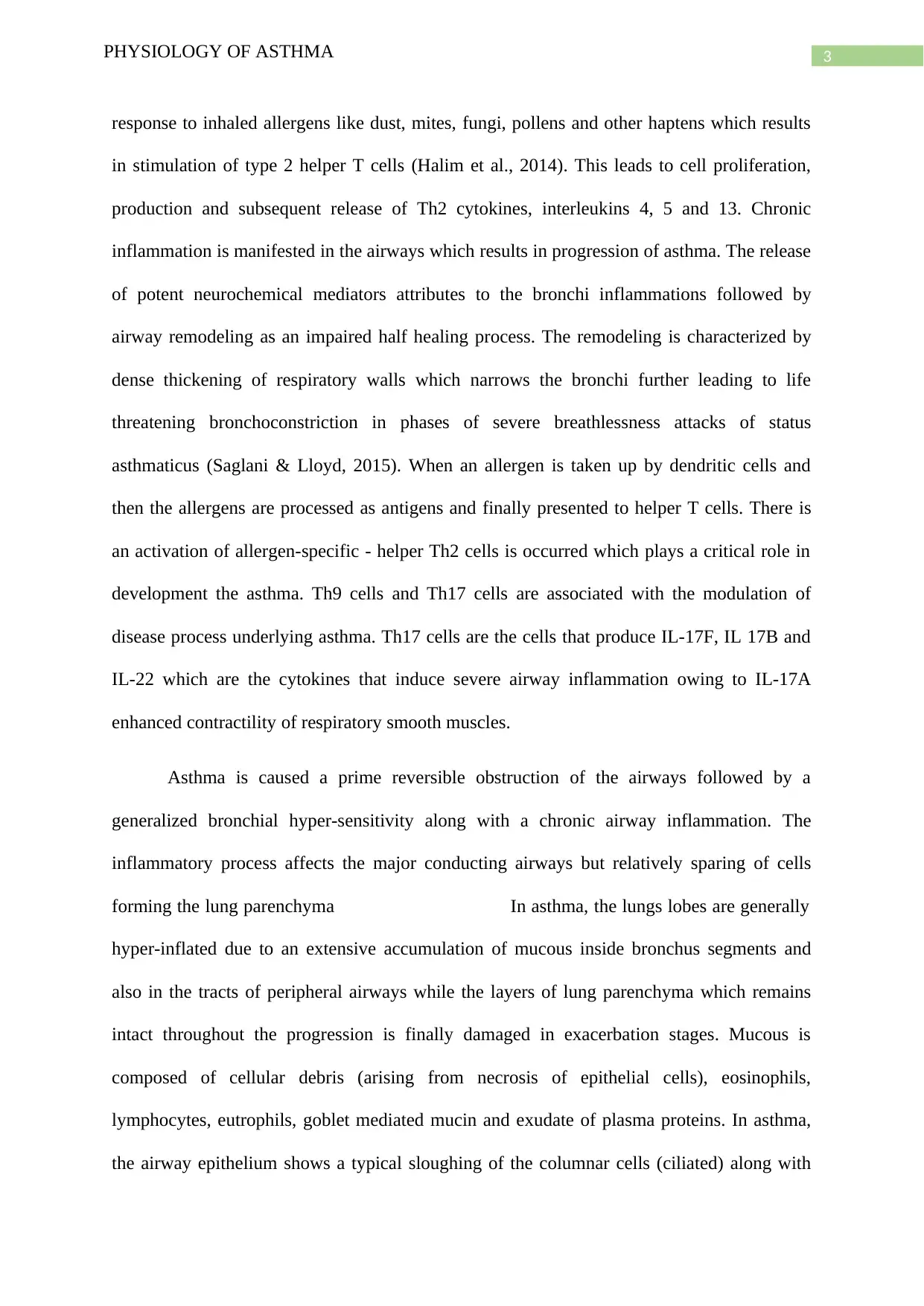
3PHYSIOLOGY OF ASTHMA
response to inhaled allergens like dust, mites, fungi, pollens and other haptens which results
in stimulation of type 2 helper T cells (Halim et al., 2014). This leads to cell proliferation,
production and subsequent release of Th2 cytokines, interleukins 4, 5 and 13. Chronic
inflammation is manifested in the airways which results in progression of asthma. The release
of potent neurochemical mediators attributes to the bronchi inflammations followed by
airway remodeling as an impaired half healing process. The remodeling is characterized by
dense thickening of respiratory walls which narrows the bronchi further leading to life
threatening bronchoconstriction in phases of severe breathlessness attacks of status
asthmaticus (Saglani & Lloyd, 2015). When an allergen is taken up by dendritic cells and
then the allergens are processed as antigens and finally presented to helper T cells. There is
an activation of allergen-specific - helper Th2 cells is occurred which plays a critical role in
development the asthma. Th9 cells and Th17 cells are associated with the modulation of
disease process underlying asthma. Th17 cells are the cells that produce IL-17F, IL 17B and
IL-22 which are the cytokines that induce severe airway inflammation owing to IL-17A
enhanced contractility of respiratory smooth muscles.
Asthma is caused a prime reversible obstruction of the airways followed by a
generalized bronchial hyper-sensitivity along with a chronic airway inflammation. The
inflammatory process affects the major conducting airways but relatively sparing of cells
forming the lung parenchyma In asthma, the lungs lobes are generally
hyper-inflated due to an extensive accumulation of mucous inside bronchus segments and
also in the tracts of peripheral airways while the layers of lung parenchyma which remains
intact throughout the progression is finally damaged in exacerbation stages. Mucous is
composed of cellular debris (arising from necrosis of epithelial cells), eosinophils,
lymphocytes, eutrophils, goblet mediated mucin and exudate of plasma proteins. In asthma,
the airway epithelium shows a typical sloughing of the columnar cells (ciliated) along with
response to inhaled allergens like dust, mites, fungi, pollens and other haptens which results
in stimulation of type 2 helper T cells (Halim et al., 2014). This leads to cell proliferation,
production and subsequent release of Th2 cytokines, interleukins 4, 5 and 13. Chronic
inflammation is manifested in the airways which results in progression of asthma. The release
of potent neurochemical mediators attributes to the bronchi inflammations followed by
airway remodeling as an impaired half healing process. The remodeling is characterized by
dense thickening of respiratory walls which narrows the bronchi further leading to life
threatening bronchoconstriction in phases of severe breathlessness attacks of status
asthmaticus (Saglani & Lloyd, 2015). When an allergen is taken up by dendritic cells and
then the allergens are processed as antigens and finally presented to helper T cells. There is
an activation of allergen-specific - helper Th2 cells is occurred which plays a critical role in
development the asthma. Th9 cells and Th17 cells are associated with the modulation of
disease process underlying asthma. Th17 cells are the cells that produce IL-17F, IL 17B and
IL-22 which are the cytokines that induce severe airway inflammation owing to IL-17A
enhanced contractility of respiratory smooth muscles.
Asthma is caused a prime reversible obstruction of the airways followed by a
generalized bronchial hyper-sensitivity along with a chronic airway inflammation. The
inflammatory process affects the major conducting airways but relatively sparing of cells
forming the lung parenchyma In asthma, the lungs lobes are generally
hyper-inflated due to an extensive accumulation of mucous inside bronchus segments and
also in the tracts of peripheral airways while the layers of lung parenchyma which remains
intact throughout the progression is finally damaged in exacerbation stages. Mucous is
composed of cellular debris (arising from necrosis of epithelial cells), eosinophils,
lymphocytes, eutrophils, goblet mediated mucin and exudate of plasma proteins. In asthma,
the airway epithelium shows a typical sloughing of the columnar cells (ciliated) along with
Paraphrase This Document
Need a fresh take? Get an instant paraphrase of this document with our AI Paraphraser
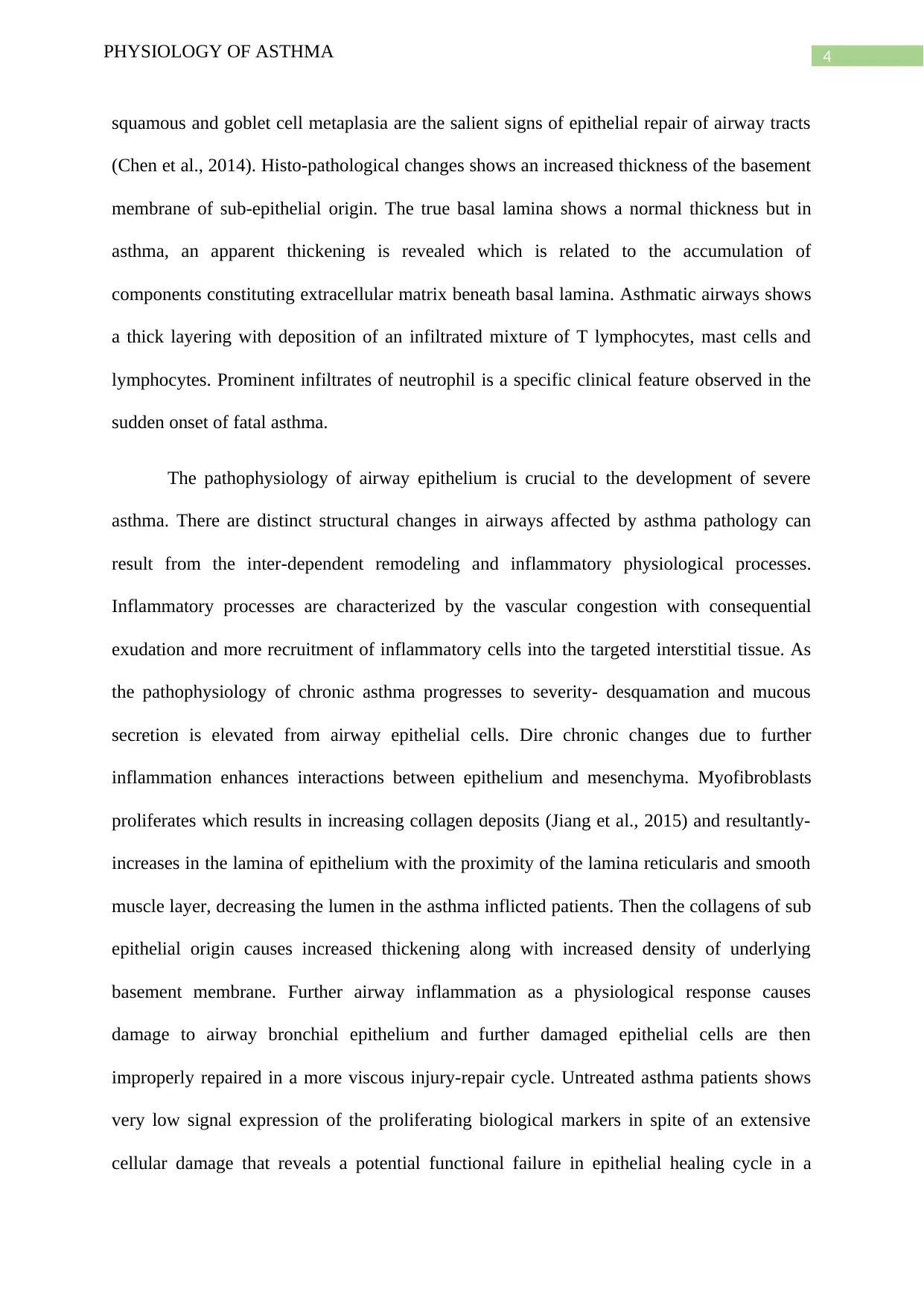
4PHYSIOLOGY OF ASTHMA
squamous and goblet cell metaplasia are the salient signs of epithelial repair of airway tracts
(Chen et al., 2014). Histo-pathological changes shows an increased thickness of the basement
membrane of sub-epithelial origin. The true basal lamina shows a normal thickness but in
asthma, an apparent thickening is revealed which is related to the accumulation of
components constituting extracellular matrix beneath basal lamina. Asthmatic airways shows
a thick layering with deposition of an infiltrated mixture of T lymphocytes, mast cells and
lymphocytes. Prominent infiltrates of neutrophil is a specific clinical feature observed in the
sudden onset of fatal asthma.
The pathophysiology of airway epithelium is crucial to the development of severe
asthma. There are distinct structural changes in airways affected by asthma pathology can
result from the inter-dependent remodeling and inflammatory physiological processes.
Inflammatory processes are characterized by the vascular congestion with consequential
exudation and more recruitment of inflammatory cells into the targeted interstitial tissue. As
the pathophysiology of chronic asthma progresses to severity- desquamation and mucous
secretion is elevated from airway epithelial cells. Dire chronic changes due to further
inflammation enhances interactions between epithelium and mesenchyma. Myofibroblasts
proliferates which results in increasing collagen deposits (Jiang et al., 2015) and resultantly-
increases in the lamina of epithelium with the proximity of the lamina reticularis and smooth
muscle layer, decreasing the lumen in the asthma inflicted patients. Then the collagens of sub
epithelial origin causes increased thickening along with increased density of underlying
basement membrane. Further airway inflammation as a physiological response causes
damage to airway bronchial epithelium and further damaged epithelial cells are then
improperly repaired in a more viscous injury-repair cycle. Untreated asthma patients shows
very low signal expression of the proliferating biological markers in spite of an extensive
cellular damage that reveals a potential functional failure in epithelial healing cycle in a
squamous and goblet cell metaplasia are the salient signs of epithelial repair of airway tracts
(Chen et al., 2014). Histo-pathological changes shows an increased thickness of the basement
membrane of sub-epithelial origin. The true basal lamina shows a normal thickness but in
asthma, an apparent thickening is revealed which is related to the accumulation of
components constituting extracellular matrix beneath basal lamina. Asthmatic airways shows
a thick layering with deposition of an infiltrated mixture of T lymphocytes, mast cells and
lymphocytes. Prominent infiltrates of neutrophil is a specific clinical feature observed in the
sudden onset of fatal asthma.
The pathophysiology of airway epithelium is crucial to the development of severe
asthma. There are distinct structural changes in airways affected by asthma pathology can
result from the inter-dependent remodeling and inflammatory physiological processes.
Inflammatory processes are characterized by the vascular congestion with consequential
exudation and more recruitment of inflammatory cells into the targeted interstitial tissue. As
the pathophysiology of chronic asthma progresses to severity- desquamation and mucous
secretion is elevated from airway epithelial cells. Dire chronic changes due to further
inflammation enhances interactions between epithelium and mesenchyma. Myofibroblasts
proliferates which results in increasing collagen deposits (Jiang et al., 2015) and resultantly-
increases in the lamina of epithelium with the proximity of the lamina reticularis and smooth
muscle layer, decreasing the lumen in the asthma inflicted patients. Then the collagens of sub
epithelial origin causes increased thickening along with increased density of underlying
basement membrane. Further airway inflammation as a physiological response causes
damage to airway bronchial epithelium and further damaged epithelial cells are then
improperly repaired in a more viscous injury-repair cycle. Untreated asthma patients shows
very low signal expression of the proliferating biological markers in spite of an extensive
cellular damage that reveals a potential functional failure in epithelial healing cycle in a
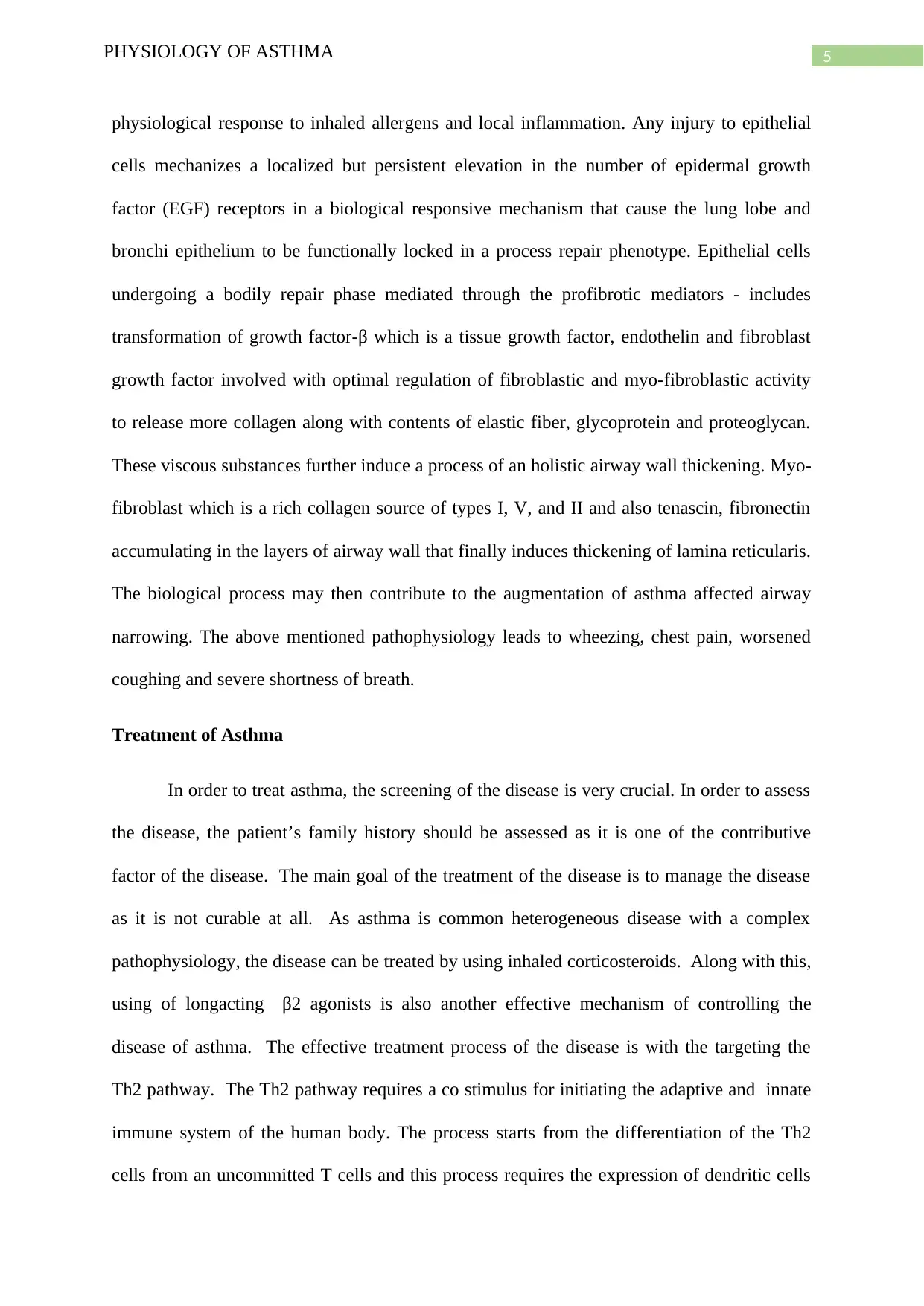
5PHYSIOLOGY OF ASTHMA
physiological response to inhaled allergens and local inflammation. Any injury to epithelial
cells mechanizes a localized but persistent elevation in the number of epidermal growth
factor (EGF) receptors in a biological responsive mechanism that cause the lung lobe and
bronchi epithelium to be functionally locked in a process repair phenotype. Epithelial cells
undergoing a bodily repair phase mediated through the profibrotic mediators - includes
transformation of growth factor-β which is a tissue growth factor, endothelin and fibroblast
growth factor involved with optimal regulation of fibroblastic and myo-fibroblastic activity
to release more collagen along with contents of elastic fiber, glycoprotein and proteoglycan.
These viscous substances further induce a process of an holistic airway wall thickening. Myo-
fibroblast which is a rich collagen source of types I, V, and II and also tenascin, fibronectin
accumulating in the layers of airway wall that finally induces thickening of lamina reticularis.
The biological process may then contribute to the augmentation of asthma affected airway
narrowing. The above mentioned pathophysiology leads to wheezing, chest pain, worsened
coughing and severe shortness of breath.
Treatment of Asthma
In order to treat asthma, the screening of the disease is very crucial. In order to assess
the disease, the patient’s family history should be assessed as it is one of the contributive
factor of the disease. The main goal of the treatment of the disease is to manage the disease
as it is not curable at all. As asthma is common heterogeneous disease with a complex
pathophysiology, the disease can be treated by using inhaled corticosteroids. Along with this,
using of longacting β2 agonists is also another effective mechanism of controlling the
disease of asthma. The effective treatment process of the disease is with the targeting the
Th2 pathway. The Th2 pathway requires a co stimulus for initiating the adaptive and innate
immune system of the human body. The process starts from the differentiation of the Th2
cells from an uncommitted T cells and this process requires the expression of dendritic cells
physiological response to inhaled allergens and local inflammation. Any injury to epithelial
cells mechanizes a localized but persistent elevation in the number of epidermal growth
factor (EGF) receptors in a biological responsive mechanism that cause the lung lobe and
bronchi epithelium to be functionally locked in a process repair phenotype. Epithelial cells
undergoing a bodily repair phase mediated through the profibrotic mediators - includes
transformation of growth factor-β which is a tissue growth factor, endothelin and fibroblast
growth factor involved with optimal regulation of fibroblastic and myo-fibroblastic activity
to release more collagen along with contents of elastic fiber, glycoprotein and proteoglycan.
These viscous substances further induce a process of an holistic airway wall thickening. Myo-
fibroblast which is a rich collagen source of types I, V, and II and also tenascin, fibronectin
accumulating in the layers of airway wall that finally induces thickening of lamina reticularis.
The biological process may then contribute to the augmentation of asthma affected airway
narrowing. The above mentioned pathophysiology leads to wheezing, chest pain, worsened
coughing and severe shortness of breath.
Treatment of Asthma
In order to treat asthma, the screening of the disease is very crucial. In order to assess
the disease, the patient’s family history should be assessed as it is one of the contributive
factor of the disease. The main goal of the treatment of the disease is to manage the disease
as it is not curable at all. As asthma is common heterogeneous disease with a complex
pathophysiology, the disease can be treated by using inhaled corticosteroids. Along with this,
using of longacting β2 agonists is also another effective mechanism of controlling the
disease of asthma. The effective treatment process of the disease is with the targeting the
Th2 pathway. The Th2 pathway requires a co stimulus for initiating the adaptive and innate
immune system of the human body. The process starts from the differentiation of the Th2
cells from an uncommitted T cells and this process requires the expression of dendritic cells
⊘ This is a preview!⊘
Do you want full access?
Subscribe today to unlock all pages.

Trusted by 1+ million students worldwide
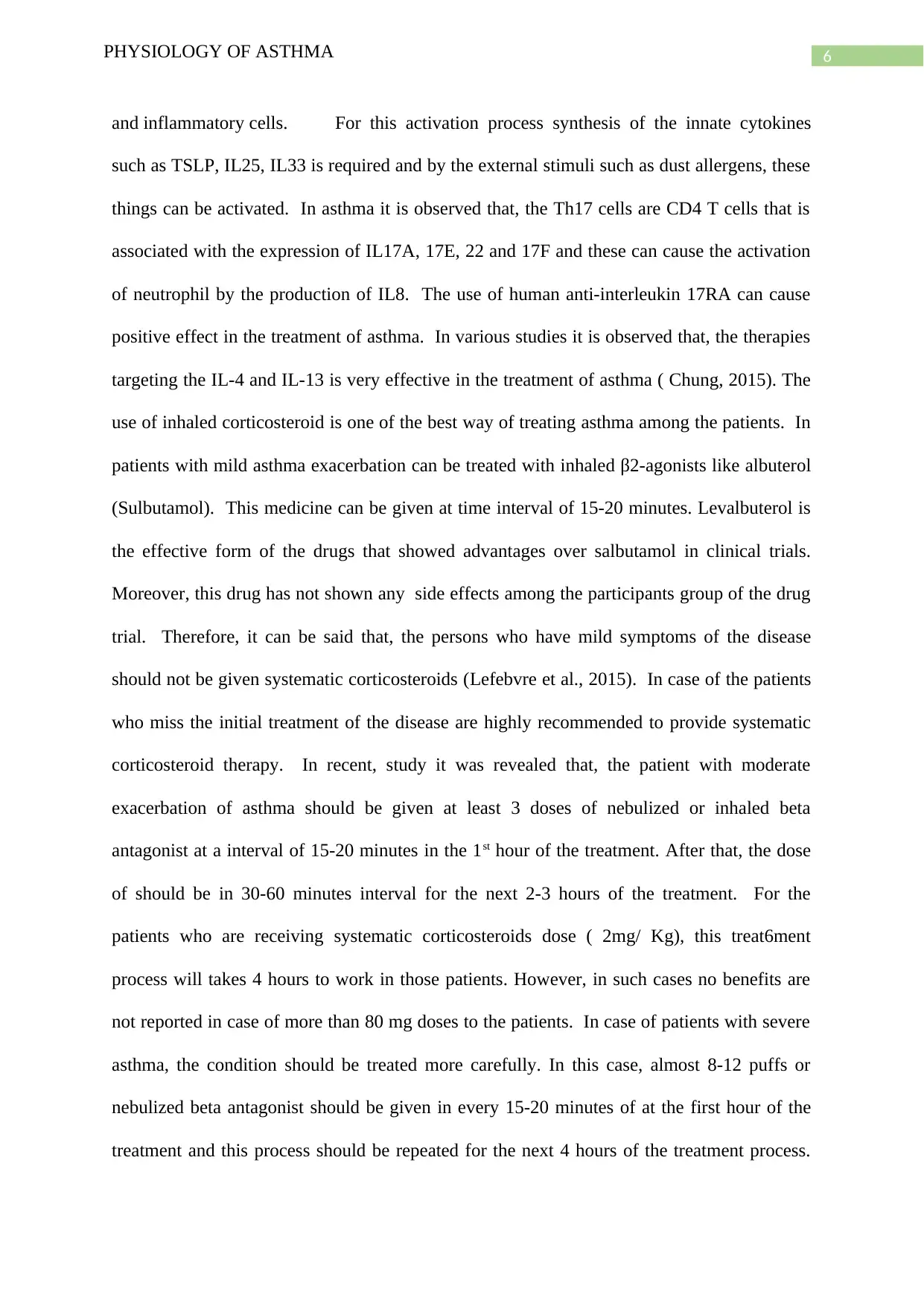
6PHYSIOLOGY OF ASTHMA
and inflammatory cells. For this activation process synthesis of the innate cytokines
such as TSLP, IL25, IL33 is required and by the external stimuli such as dust allergens, these
things can be activated. In asthma it is observed that, the Th17 cells are CD4 T cells that is
associated with the expression of IL17A, 17E, 22 and 17F and these can cause the activation
of neutrophil by the production of IL8. The use of human anti-interleukin 17RA can cause
positive effect in the treatment of asthma. In various studies it is observed that, the therapies
targeting the IL-4 and IL-13 is very effective in the treatment of asthma ( Chung, 2015). The
use of inhaled corticosteroid is one of the best way of treating asthma among the patients. In
patients with mild asthma exacerbation can be treated with inhaled β2-agonists like albuterol
(Sulbutamol). This medicine can be given at time interval of 15-20 minutes. Levalbuterol is
the effective form of the drugs that showed advantages over salbutamol in clinical trials.
Moreover, this drug has not shown any side effects among the participants group of the drug
trial. Therefore, it can be said that, the persons who have mild symptoms of the disease
should not be given systematic corticosteroids (Lefebvre et al., 2015). In case of the patients
who miss the initial treatment of the disease are highly recommended to provide systematic
corticosteroid therapy. In recent, study it was revealed that, the patient with moderate
exacerbation of asthma should be given at least 3 doses of nebulized or inhaled beta
antagonist at a interval of 15-20 minutes in the 1st hour of the treatment. After that, the dose
of should be in 30-60 minutes interval for the next 2-3 hours of the treatment. For the
patients who are receiving systematic corticosteroids dose ( 2mg/ Kg), this treat6ment
process will takes 4 hours to work in those patients. However, in such cases no benefits are
not reported in case of more than 80 mg doses to the patients. In case of patients with severe
asthma, the condition should be treated more carefully. In this case, almost 8-12 puffs or
nebulized beta antagonist should be given in every 15-20 minutes of at the first hour of the
treatment and this process should be repeated for the next 4 hours of the treatment process.
and inflammatory cells. For this activation process synthesis of the innate cytokines
such as TSLP, IL25, IL33 is required and by the external stimuli such as dust allergens, these
things can be activated. In asthma it is observed that, the Th17 cells are CD4 T cells that is
associated with the expression of IL17A, 17E, 22 and 17F and these can cause the activation
of neutrophil by the production of IL8. The use of human anti-interleukin 17RA can cause
positive effect in the treatment of asthma. In various studies it is observed that, the therapies
targeting the IL-4 and IL-13 is very effective in the treatment of asthma ( Chung, 2015). The
use of inhaled corticosteroid is one of the best way of treating asthma among the patients. In
patients with mild asthma exacerbation can be treated with inhaled β2-agonists like albuterol
(Sulbutamol). This medicine can be given at time interval of 15-20 minutes. Levalbuterol is
the effective form of the drugs that showed advantages over salbutamol in clinical trials.
Moreover, this drug has not shown any side effects among the participants group of the drug
trial. Therefore, it can be said that, the persons who have mild symptoms of the disease
should not be given systematic corticosteroids (Lefebvre et al., 2015). In case of the patients
who miss the initial treatment of the disease are highly recommended to provide systematic
corticosteroid therapy. In recent, study it was revealed that, the patient with moderate
exacerbation of asthma should be given at least 3 doses of nebulized or inhaled beta
antagonist at a interval of 15-20 minutes in the 1st hour of the treatment. After that, the dose
of should be in 30-60 minutes interval for the next 2-3 hours of the treatment. For the
patients who are receiving systematic corticosteroids dose ( 2mg/ Kg), this treat6ment
process will takes 4 hours to work in those patients. However, in such cases no benefits are
not reported in case of more than 80 mg doses to the patients. In case of patients with severe
asthma, the condition should be treated more carefully. In this case, almost 8-12 puffs or
nebulized beta antagonist should be given in every 15-20 minutes of at the first hour of the
treatment and this process should be repeated for the next 4 hours of the treatment process.
Paraphrase This Document
Need a fresh take? Get an instant paraphrase of this document with our AI Paraphraser
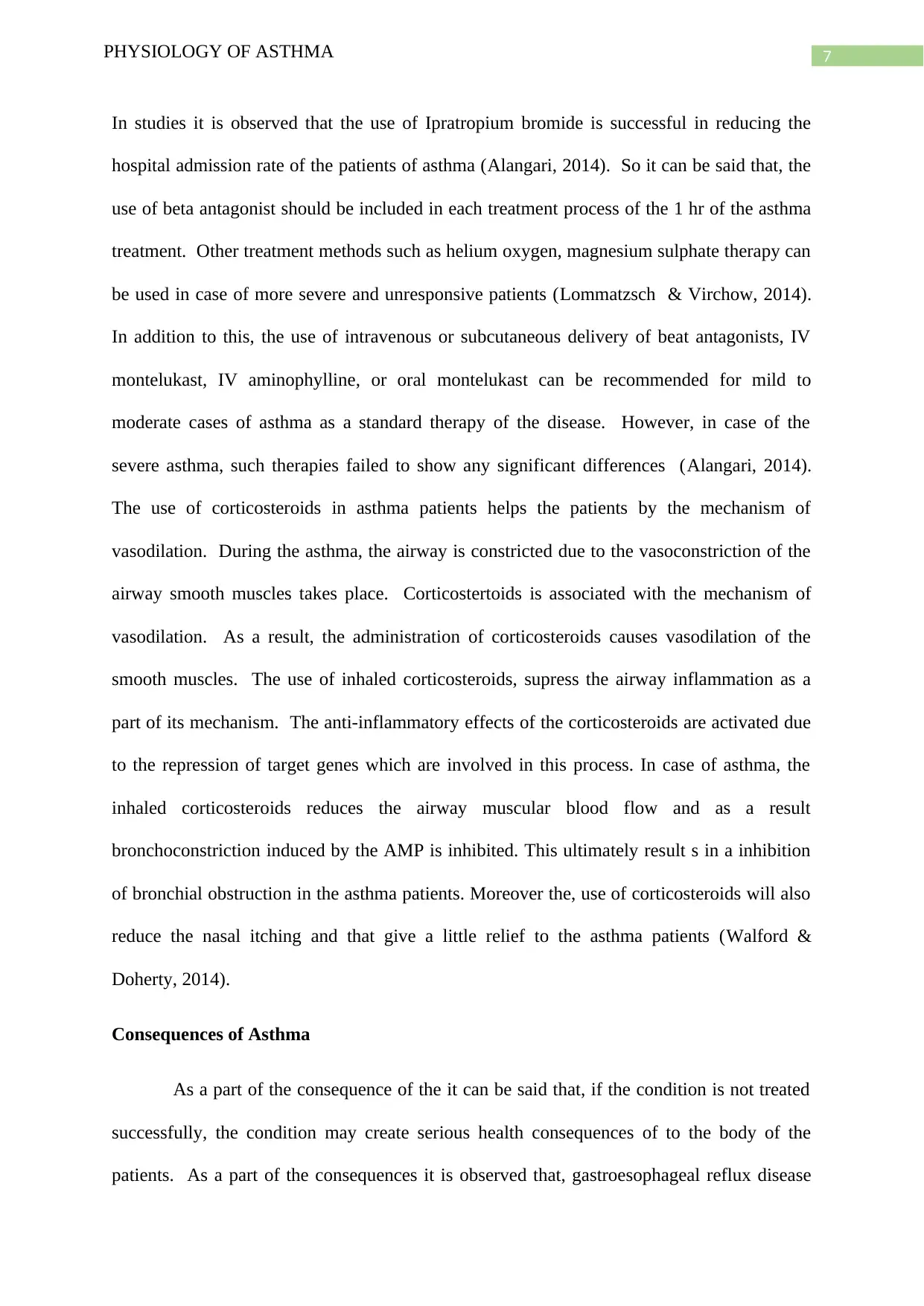
7PHYSIOLOGY OF ASTHMA
In studies it is observed that the use of Ipratropium bromide is successful in reducing the
hospital admission rate of the patients of asthma (Alangari, 2014). So it can be said that, the
use of beta antagonist should be included in each treatment process of the 1 hr of the asthma
treatment. Other treatment methods such as helium oxygen, magnesium sulphate therapy can
be used in case of more severe and unresponsive patients (Lommatzsch & Virchow, 2014).
In addition to this, the use of intravenous or subcutaneous delivery of beat antagonists, IV
montelukast, IV aminophylline, or oral montelukast can be recommended for mild to
moderate cases of asthma as a standard therapy of the disease. However, in case of the
severe asthma, such therapies failed to show any significant differences (Alangari, 2014).
The use of corticosteroids in asthma patients helps the patients by the mechanism of
vasodilation. During the asthma, the airway is constricted due to the vasoconstriction of the
airway smooth muscles takes place. Corticostertoids is associated with the mechanism of
vasodilation. As a result, the administration of corticosteroids causes vasodilation of the
smooth muscles. The use of inhaled corticosteroids, supress the airway inflammation as a
part of its mechanism. The anti-inflammatory effects of the corticosteroids are activated due
to the repression of target genes which are involved in this process. In case of asthma, the
inhaled corticosteroids reduces the airway muscular blood flow and as a result
bronchoconstriction induced by the AMP is inhibited. This ultimately result s in a inhibition
of bronchial obstruction in the asthma patients. Moreover the, use of corticosteroids will also
reduce the nasal itching and that give a little relief to the asthma patients (Walford &
Doherty, 2014).
Consequences of Asthma
As a part of the consequence of the it can be said that, if the condition is not treated
successfully, the condition may create serious health consequences of to the body of the
patients. As a part of the consequences it is observed that, gastroesophageal reflux disease
In studies it is observed that the use of Ipratropium bromide is successful in reducing the
hospital admission rate of the patients of asthma (Alangari, 2014). So it can be said that, the
use of beta antagonist should be included in each treatment process of the 1 hr of the asthma
treatment. Other treatment methods such as helium oxygen, magnesium sulphate therapy can
be used in case of more severe and unresponsive patients (Lommatzsch & Virchow, 2014).
In addition to this, the use of intravenous or subcutaneous delivery of beat antagonists, IV
montelukast, IV aminophylline, or oral montelukast can be recommended for mild to
moderate cases of asthma as a standard therapy of the disease. However, in case of the
severe asthma, such therapies failed to show any significant differences (Alangari, 2014).
The use of corticosteroids in asthma patients helps the patients by the mechanism of
vasodilation. During the asthma, the airway is constricted due to the vasoconstriction of the
airway smooth muscles takes place. Corticostertoids is associated with the mechanism of
vasodilation. As a result, the administration of corticosteroids causes vasodilation of the
smooth muscles. The use of inhaled corticosteroids, supress the airway inflammation as a
part of its mechanism. The anti-inflammatory effects of the corticosteroids are activated due
to the repression of target genes which are involved in this process. In case of asthma, the
inhaled corticosteroids reduces the airway muscular blood flow and as a result
bronchoconstriction induced by the AMP is inhibited. This ultimately result s in a inhibition
of bronchial obstruction in the asthma patients. Moreover the, use of corticosteroids will also
reduce the nasal itching and that give a little relief to the asthma patients (Walford &
Doherty, 2014).
Consequences of Asthma
As a part of the consequence of the it can be said that, if the condition is not treated
successfully, the condition may create serious health consequences of to the body of the
patients. As a part of the consequences it is observed that, gastroesophageal reflux disease
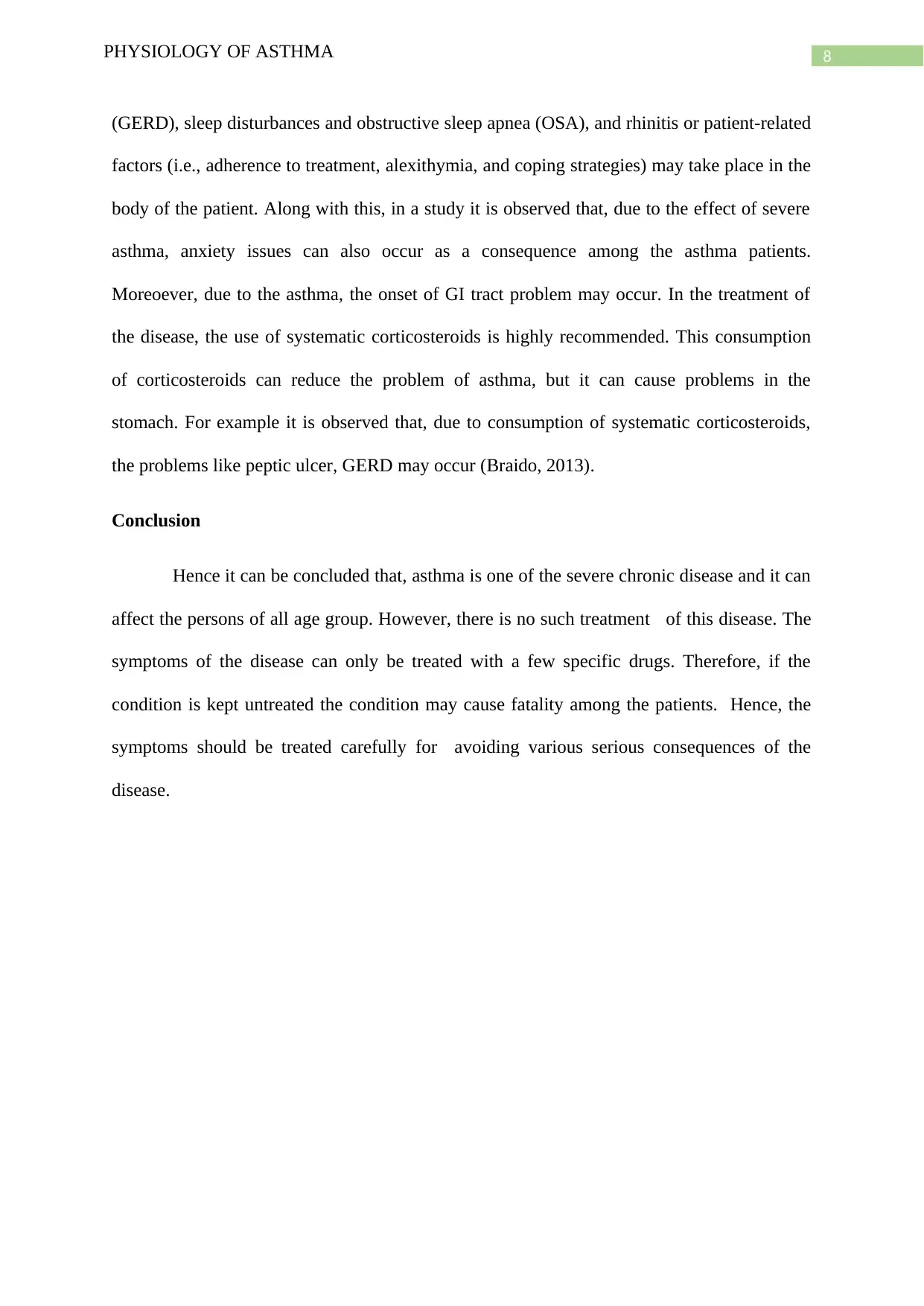
8PHYSIOLOGY OF ASTHMA
(GERD), sleep disturbances and obstructive sleep apnea (OSA), and rhinitis or patient-related
factors (i.e., adherence to treatment, alexithymia, and coping strategies) may take place in the
body of the patient. Along with this, in a study it is observed that, due to the effect of severe
asthma, anxiety issues can also occur as a consequence among the asthma patients.
Moreoever, due to the asthma, the onset of GI tract problem may occur. In the treatment of
the disease, the use of systematic corticosteroids is highly recommended. This consumption
of corticosteroids can reduce the problem of asthma, but it can cause problems in the
stomach. For example it is observed that, due to consumption of systematic corticosteroids,
the problems like peptic ulcer, GERD may occur (Braido, 2013).
Conclusion
Hence it can be concluded that, asthma is one of the severe chronic disease and it can
affect the persons of all age group. However, there is no such treatment of this disease. The
symptoms of the disease can only be treated with a few specific drugs. Therefore, if the
condition is kept untreated the condition may cause fatality among the patients. Hence, the
symptoms should be treated carefully for avoiding various serious consequences of the
disease.
(GERD), sleep disturbances and obstructive sleep apnea (OSA), and rhinitis or patient-related
factors (i.e., adherence to treatment, alexithymia, and coping strategies) may take place in the
body of the patient. Along with this, in a study it is observed that, due to the effect of severe
asthma, anxiety issues can also occur as a consequence among the asthma patients.
Moreoever, due to the asthma, the onset of GI tract problem may occur. In the treatment of
the disease, the use of systematic corticosteroids is highly recommended. This consumption
of corticosteroids can reduce the problem of asthma, but it can cause problems in the
stomach. For example it is observed that, due to consumption of systematic corticosteroids,
the problems like peptic ulcer, GERD may occur (Braido, 2013).
Conclusion
Hence it can be concluded that, asthma is one of the severe chronic disease and it can
affect the persons of all age group. However, there is no such treatment of this disease. The
symptoms of the disease can only be treated with a few specific drugs. Therefore, if the
condition is kept untreated the condition may cause fatality among the patients. Hence, the
symptoms should be treated carefully for avoiding various serious consequences of the
disease.
⊘ This is a preview!⊘
Do you want full access?
Subscribe today to unlock all pages.

Trusted by 1+ million students worldwide
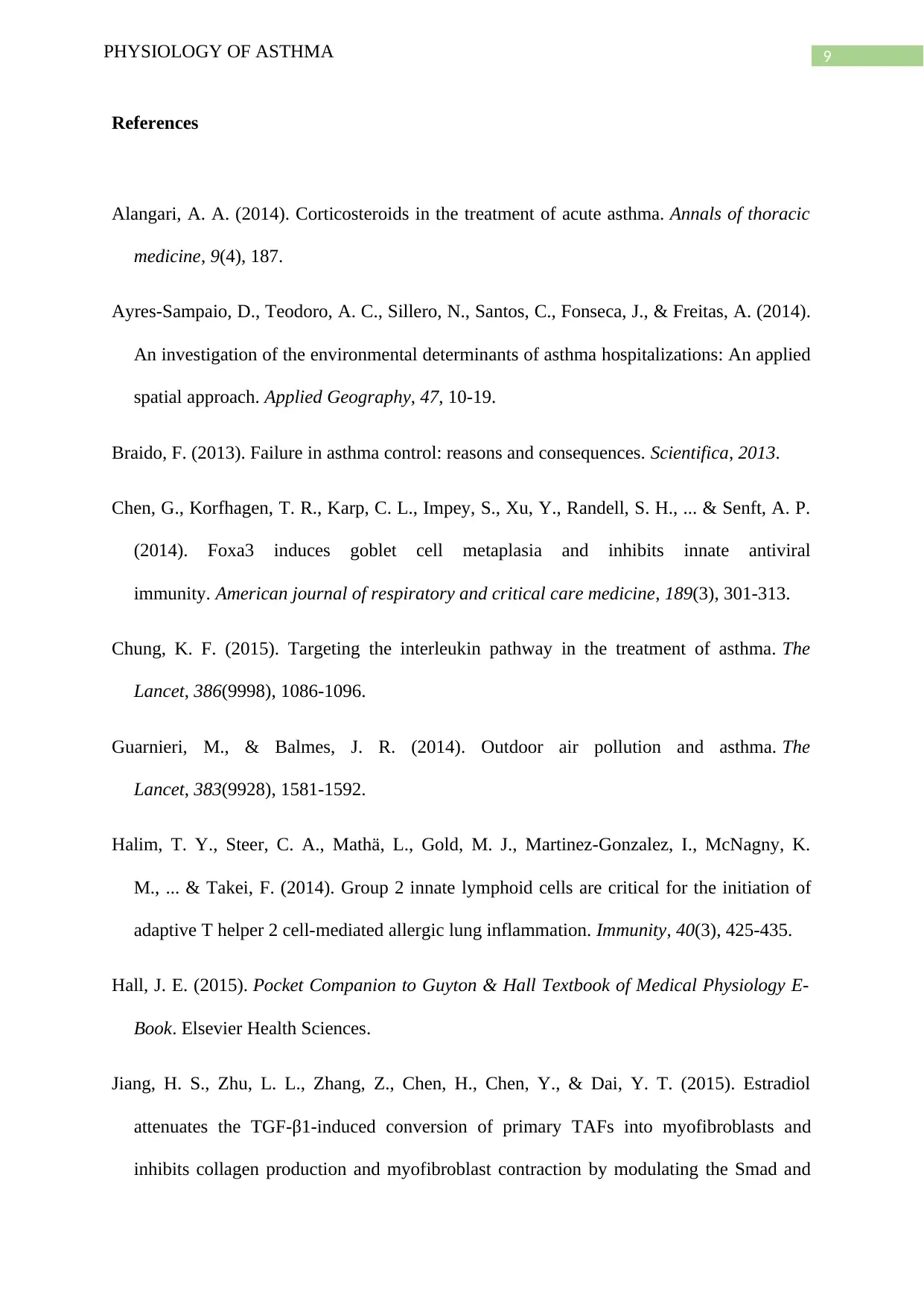
9PHYSIOLOGY OF ASTHMA
References
Alangari, A. A. (2014). Corticosteroids in the treatment of acute asthma. Annals of thoracic
medicine, 9(4), 187.
Ayres-Sampaio, D., Teodoro, A. C., Sillero, N., Santos, C., Fonseca, J., & Freitas, A. (2014).
An investigation of the environmental determinants of asthma hospitalizations: An applied
spatial approach. Applied Geography, 47, 10-19.
Braido, F. (2013). Failure in asthma control: reasons and consequences. Scientifica, 2013.
Chen, G., Korfhagen, T. R., Karp, C. L., Impey, S., Xu, Y., Randell, S. H., ... & Senft, A. P.
(2014). Foxa3 induces goblet cell metaplasia and inhibits innate antiviral
immunity. American journal of respiratory and critical care medicine, 189(3), 301-313.
Chung, K. F. (2015). Targeting the interleukin pathway in the treatment of asthma. The
Lancet, 386(9998), 1086-1096.
Guarnieri, M., & Balmes, J. R. (2014). Outdoor air pollution and asthma. The
Lancet, 383(9928), 1581-1592.
Halim, T. Y., Steer, C. A., Mathä, L., Gold, M. J., Martinez-Gonzalez, I., McNagny, K.
M., ... & Takei, F. (2014). Group 2 innate lymphoid cells are critical for the initiation of
adaptive T helper 2 cell-mediated allergic lung inflammation. Immunity, 40(3), 425-435.
Hall, J. E. (2015). Pocket Companion to Guyton & Hall Textbook of Medical Physiology E-
Book. Elsevier Health Sciences.
Jiang, H. S., Zhu, L. L., Zhang, Z., Chen, H., Chen, Y., & Dai, Y. T. (2015). Estradiol
attenuates the TGF-β1-induced conversion of primary TAFs into myofibroblasts and
inhibits collagen production and myofibroblast contraction by modulating the Smad and
References
Alangari, A. A. (2014). Corticosteroids in the treatment of acute asthma. Annals of thoracic
medicine, 9(4), 187.
Ayres-Sampaio, D., Teodoro, A. C., Sillero, N., Santos, C., Fonseca, J., & Freitas, A. (2014).
An investigation of the environmental determinants of asthma hospitalizations: An applied
spatial approach. Applied Geography, 47, 10-19.
Braido, F. (2013). Failure in asthma control: reasons and consequences. Scientifica, 2013.
Chen, G., Korfhagen, T. R., Karp, C. L., Impey, S., Xu, Y., Randell, S. H., ... & Senft, A. P.
(2014). Foxa3 induces goblet cell metaplasia and inhibits innate antiviral
immunity. American journal of respiratory and critical care medicine, 189(3), 301-313.
Chung, K. F. (2015). Targeting the interleukin pathway in the treatment of asthma. The
Lancet, 386(9998), 1086-1096.
Guarnieri, M., & Balmes, J. R. (2014). Outdoor air pollution and asthma. The
Lancet, 383(9928), 1581-1592.
Halim, T. Y., Steer, C. A., Mathä, L., Gold, M. J., Martinez-Gonzalez, I., McNagny, K.
M., ... & Takei, F. (2014). Group 2 innate lymphoid cells are critical for the initiation of
adaptive T helper 2 cell-mediated allergic lung inflammation. Immunity, 40(3), 425-435.
Hall, J. E. (2015). Pocket Companion to Guyton & Hall Textbook of Medical Physiology E-
Book. Elsevier Health Sciences.
Jiang, H. S., Zhu, L. L., Zhang, Z., Chen, H., Chen, Y., & Dai, Y. T. (2015). Estradiol
attenuates the TGF-β1-induced conversion of primary TAFs into myofibroblasts and
inhibits collagen production and myofibroblast contraction by modulating the Smad and
Paraphrase This Document
Need a fresh take? Get an instant paraphrase of this document with our AI Paraphraser
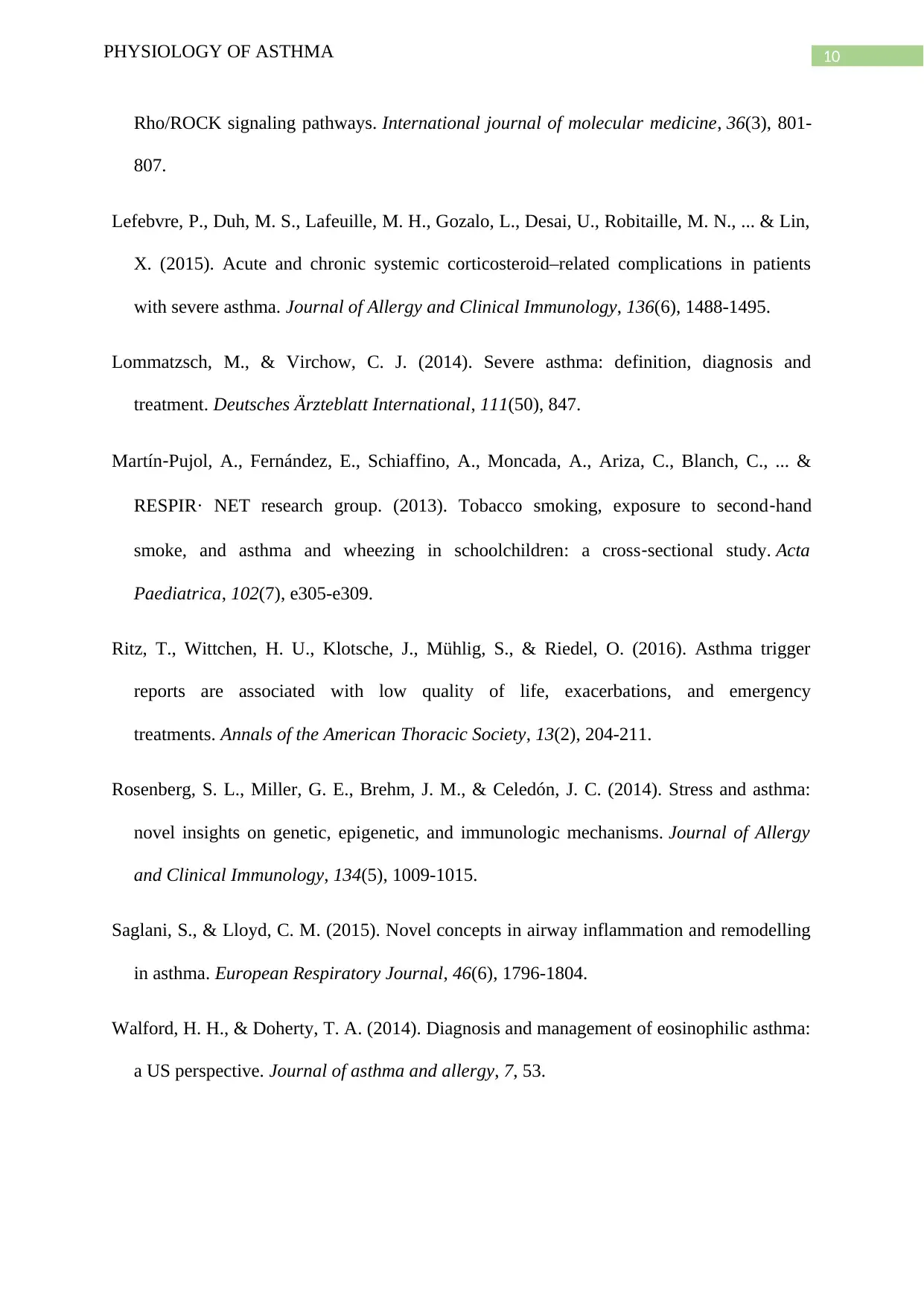
10PHYSIOLOGY OF ASTHMA
Rho/ROCK signaling pathways. International journal of molecular medicine, 36(3), 801-
807.
Lefebvre, P., Duh, M. S., Lafeuille, M. H., Gozalo, L., Desai, U., Robitaille, M. N., ... & Lin,
X. (2015). Acute and chronic systemic corticosteroid–related complications in patients
with severe asthma. Journal of Allergy and Clinical Immunology, 136(6), 1488-1495.
Lommatzsch, M., & Virchow, C. J. (2014). Severe asthma: definition, diagnosis and
treatment. Deutsches Ärzteblatt International, 111(50), 847.
Martín‐Pujol, A., Fernández, E., Schiaffino, A., Moncada, A., Ariza, C., Blanch, C., ... &
RESPIR· NET research group. (2013). Tobacco smoking, exposure to second‐hand
smoke, and asthma and wheezing in schoolchildren: a cross‐sectional study. Acta
Paediatrica, 102(7), e305-e309.
Ritz, T., Wittchen, H. U., Klotsche, J., Mühlig, S., & Riedel, O. (2016). Asthma trigger
reports are associated with low quality of life, exacerbations, and emergency
treatments. Annals of the American Thoracic Society, 13(2), 204-211.
Rosenberg, S. L., Miller, G. E., Brehm, J. M., & Celedón, J. C. (2014). Stress and asthma:
novel insights on genetic, epigenetic, and immunologic mechanisms. Journal of Allergy
and Clinical Immunology, 134(5), 1009-1015.
Saglani, S., & Lloyd, C. M. (2015). Novel concepts in airway inflammation and remodelling
in asthma. European Respiratory Journal, 46(6), 1796-1804.
Walford, H. H., & Doherty, T. A. (2014). Diagnosis and management of eosinophilic asthma:
a US perspective. Journal of asthma and allergy, 7, 53.
Rho/ROCK signaling pathways. International journal of molecular medicine, 36(3), 801-
807.
Lefebvre, P., Duh, M. S., Lafeuille, M. H., Gozalo, L., Desai, U., Robitaille, M. N., ... & Lin,
X. (2015). Acute and chronic systemic corticosteroid–related complications in patients
with severe asthma. Journal of Allergy and Clinical Immunology, 136(6), 1488-1495.
Lommatzsch, M., & Virchow, C. J. (2014). Severe asthma: definition, diagnosis and
treatment. Deutsches Ärzteblatt International, 111(50), 847.
Martín‐Pujol, A., Fernández, E., Schiaffino, A., Moncada, A., Ariza, C., Blanch, C., ... &
RESPIR· NET research group. (2013). Tobacco smoking, exposure to second‐hand
smoke, and asthma and wheezing in schoolchildren: a cross‐sectional study. Acta
Paediatrica, 102(7), e305-e309.
Ritz, T., Wittchen, H. U., Klotsche, J., Mühlig, S., & Riedel, O. (2016). Asthma trigger
reports are associated with low quality of life, exacerbations, and emergency
treatments. Annals of the American Thoracic Society, 13(2), 204-211.
Rosenberg, S. L., Miller, G. E., Brehm, J. M., & Celedón, J. C. (2014). Stress and asthma:
novel insights on genetic, epigenetic, and immunologic mechanisms. Journal of Allergy
and Clinical Immunology, 134(5), 1009-1015.
Saglani, S., & Lloyd, C. M. (2015). Novel concepts in airway inflammation and remodelling
in asthma. European Respiratory Journal, 46(6), 1796-1804.
Walford, H. H., & Doherty, T. A. (2014). Diagnosis and management of eosinophilic asthma:
a US perspective. Journal of asthma and allergy, 7, 53.

11PHYSIOLOGY OF ASTHMA
⊘ This is a preview!⊘
Do you want full access?
Subscribe today to unlock all pages.

Trusted by 1+ million students worldwide
1 out of 12
Related Documents
Your All-in-One AI-Powered Toolkit for Academic Success.
+13062052269
info@desklib.com
Available 24*7 on WhatsApp / Email
![[object Object]](/_next/static/media/star-bottom.7253800d.svg)
Unlock your academic potential
Copyright © 2020–2025 A2Z Services. All Rights Reserved. Developed and managed by ZUCOL.





